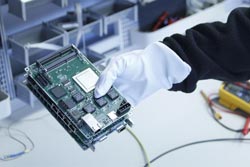Precision space maneuvers

The MUSE onboard computer allows a spacecraft to be piloted and positioned with pinpoint accuracy. © Fraunhofer FIRST<br>
Spacecraft must operate with utmost precision when conducting landing maneuvers on other planets, or docking to a space station. To ensure they do not drift off course, imaging sensors collect a fl ood of data that are analyzed in real time.
Researchers at the Fraunhofer Institute for Computer Architecture and Software Technology FIRST have engineered a system based on multicore technologies that allow spacecraft to be piloted and positioned with pinpoint accuracy. It can be seen at the embedded world trade show in Nuremberg from February 28 to March 1, 2012 (Hall 5, Booth 228).
For a spacecraft to “see” and maintain its equilibrium, it needs a high-performance onboard computer. This device must process a myriad of sensor data simultaneously, and withstand the severe conditions of outer space. Through the MUSE project (Multicore Architecture for Sensor-based Position Tracking in Space), researchers are seeking to improve the positioning and guidance of such spacecraft.
Under the plan, scientists from FIRST developed an extremely high-performing onboard computer using modern multi-core processors. High-resolution cameras and infrared or radar sensors on the spacecraft deliver immense data volumes that help determine the position of the target object. These data have to be processed in real time, in order to compute the precise control of the vehicle. Spaceflight-enabled computers to date have always had to make sacrifi ces here, in terms of quality, due to the high performance requirements.
“In space, the major challenge is this: the system must provide an enormously high computing capacity, while power supply, weight, space and cooling requirements are kept to a minimum. In addition, cosmic radiation may cause sporadic data corruption, which has to be detected and rectifi ed by means of error tolerance mechanisms,” explains Samuel Pletner, in charge of Aerospace Business Development at FIRST. “We have to reliably eliminate the possibility of undetected errors leading to erroneous guidance commands and ultimately, uncontrolled movements of the spacecraft.”
The researchers solve the problem with the P4080 Multicore Processor, manufactured by Freescale, which is highly integrated and particularly robust. Besides maximum processing capacity, more effi cient error tolerance mechanisms can also be realized with these processors. Fraunhofer experts have devised complex position-detection algorithms specially designed for multi-core architectures. Thus, critical calculations can be conducted on a number of different processor cores, and the results checked through a reliable comparison.
The MUSE project is funded by the Space Flight Agency of the German Aerospace Center DLR, with funding from the German Federal Ministry of Economics and Technology.
Media Contact
All latest news from the category: Trade Fair News
Newest articles

An Endless Loop: How Some Bacteria Evolve Along With the Seasons
The longest natural metagenome time series ever collected, with microbes, reveals a startling evolutionary pattern on repeat. A Microbial “Groundhog Year” in Lake Mendota Like Bill Murray in the movie…

Witness Groundbreaking Research on Achilles Tendon Recovery
Achilles tendon injuries are common but challenging to monitor during recovery due to the limitations of current imaging techniques. Researchers, led by Associate Professor Zeng Nan from the International Graduate…

Why Prevention Is Better Than Cure—A Novel Approach to Infectious Disease Outbreaks
Researchers have come up with a new way to identify more infectious variants of viruses or bacteria that start spreading in humans – including those causing flu, COVID, whooping cough…



